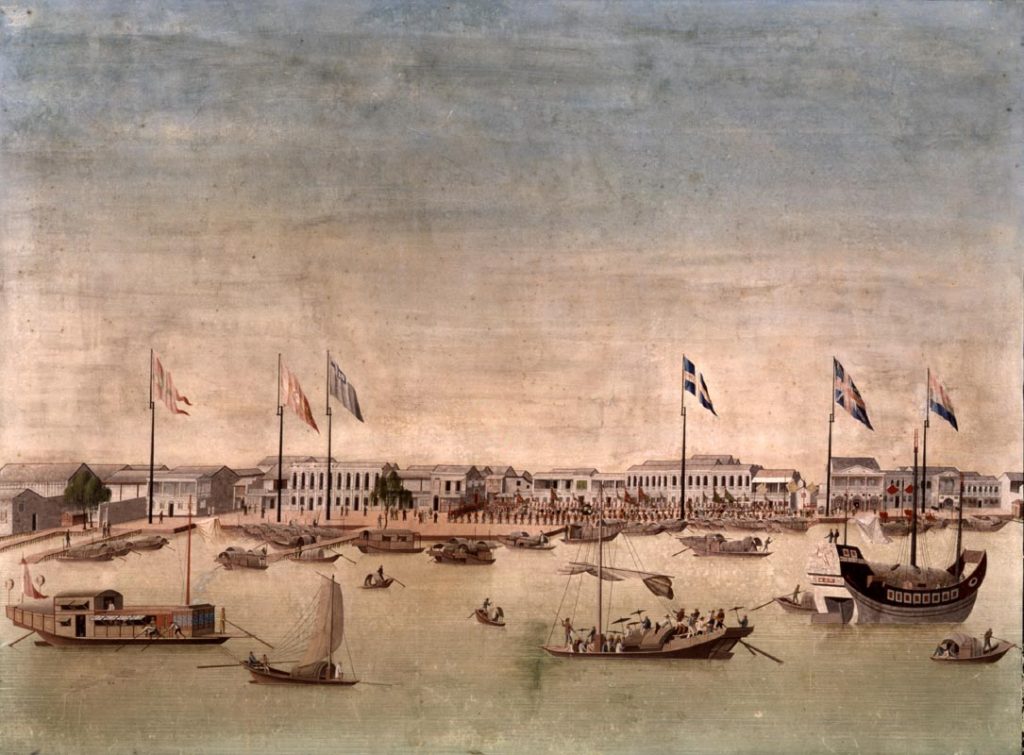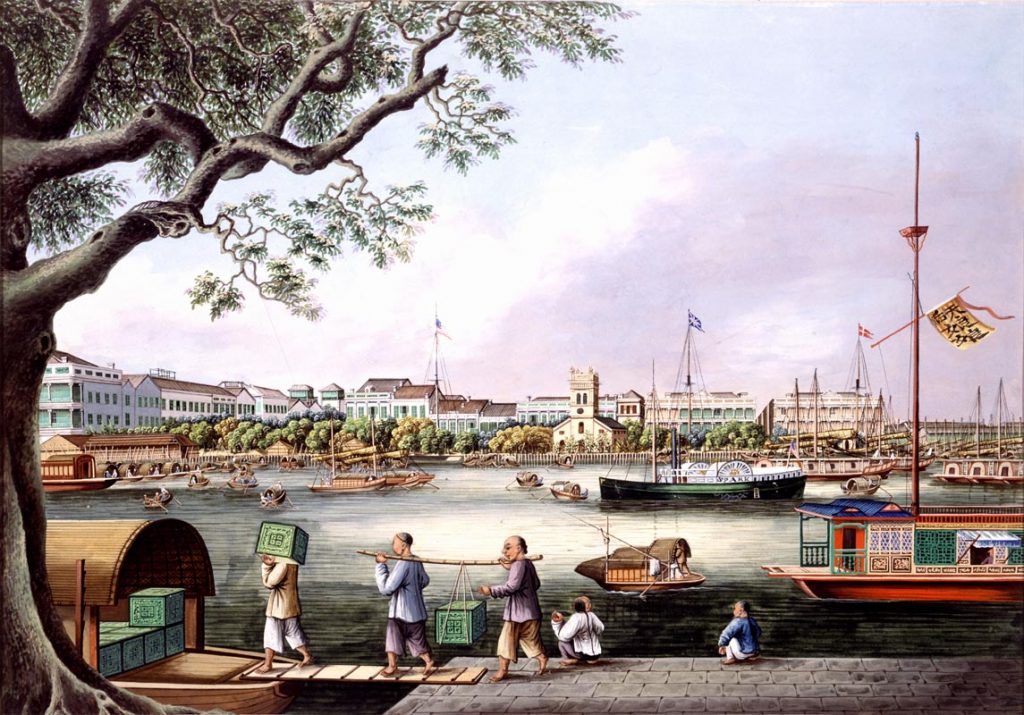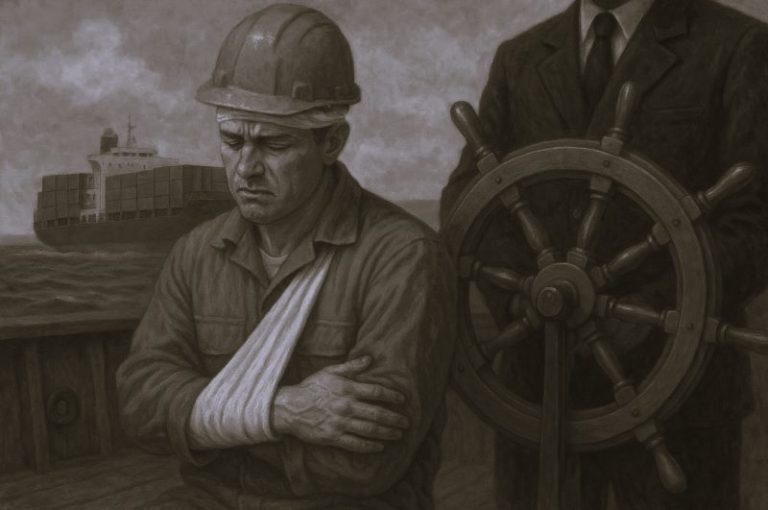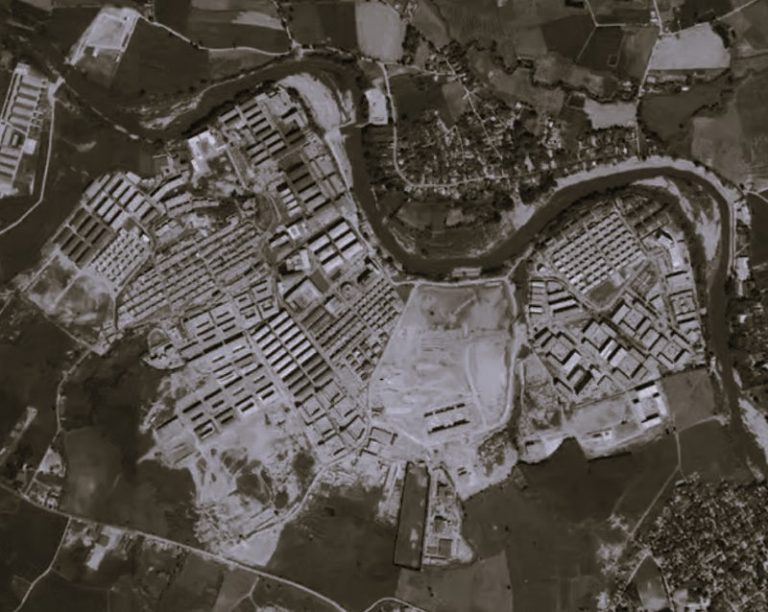
Canton’s foreign quarter, sited between the city wall and the river, fit comfortably into the classic design of south Chinese cities.

By Dr. Peter C. Perdue
Professor of History
Yale University
Canton Trade
Introduction

During the passage from Macau up the Pearl River foreigners passed through densely populated agricultural lands and market towns, but they never saw a major city until they reached Guangzhou. We call the trading system that lasted from 1700 to 1842 on China’s south coast the “Canton system” because of this city’s dominance. Guangzhou (which Europeans called Canton), an ancient city and one of the largest in South China, had flourished as an administrative and trading center for over 1000 years before the Westerners arrived. Arab and Persian traders had lived in its foreign quarters under the Tang dynasty since the 8th century. Like most traditional Chinese cities, Canton had a large wall surrounding the central districts, major avenues within the wall, extensive market districts outside the wall, and constant contact by riverboats with the surrounding countryside and distant ports.

Chinese cities were planned as segregated environments, with separate districts for different purposes. The official headquarters, usually in the north central area of the city, faced south over their subjects. Wide avenues separated residential wards from each other, and these wards often had gates. Market places were spread through the inner city, but much of the mercantile activity took place outside the city walls. In cities located on major rivers large clusters of boats, ranging from small sampans to large junks, gathered at the wharves and merchants conducted business between the river and the city wall. Canton’s foreign quarter, sited between the city wall and the river, fit comfortably into the classic design of south Chinese cities.
The Rise of the System



The Ming emperors confined Western traders to the town of Macau, but the Qing emperors expanded their access in the 18th century. The Qing rulers were Manchus from northeast China who conquered the core of Han China in the mid 17th century. As people from the borderlands, they were accustomed to relations with many different kinds of peoples and gave each group its place. They called many of the foreign peoples “tributaries,” meaning those who came to give tribute or gifts to the emperor out of gratitude for his benevolent rule. The Westerners who arrived in China to trade in the 18th century joined these tributary peoples. From the Qing official point of view, Westerners were just one of hundreds of different peoples who admired and sought to profit from their relationship with the flourishing empire.
Since the early 17th century, the Dutch and the English had tried to gain trading privileges with China as the Portuguese had done in Macau, but the Chinese rulers prevented regular access until they had secured control of Taiwan in 1683. Then the Chinese and foreigners began to negotiate regular terms of trade at several different ports. By the early 18th century, Canton had emerged as the most convenient port for both the Chinese and foreigners. The Manchu court favored foreign trade as long as it was conducted in a stable and predictable fashion under government regulation. They appointed the superintendent of customs, or hoppo, as the official responsible for collecting customs duties and managing orderly trade in Canton. Since the Cantonese already had over a century of experience dealing with the Portuguese in Macau, they could take care of the new arrivals without much difficulty.
The Qing government tightened control in 1741 by requiring all foreigners to leave Canton and return to Macau when the trading season ended, and officially restricted all trade to Canton after 1757. The foreigners constantly complained about these restrictions, but the fact that trade grew steadily through the 18th century shows that they could do very profitable business despite the regulations.
While in Canton, the foreign merchants formed a separate community. On the Chinese side, a special guild of merchants, the Co-hong, obtained a monopoly over trade with the foreigners. After paying the hoppo substantial sums for the privilege of trading with foreigners, these hong merchants profited greatly from their access to foreign trade. Although the Qing emperors kept their distance from the foreign traders, they gained a great deal of personal revenue from them. The duties from trade went directly to the imperial household.
Like their predecessors, the Qing emperors required foreigners to live in a separate quarter of the city. The foreigners lived in buildings called “factories,” which included living quarters, warehouses, and offices for trade. (These factories did not manufacture anything; the name comes from “factor,” an older English word for “commercial agent.”) The Chinese called them “hongs,” or merchant shops. The factory buildings lined up along the waterfront, each with its distinctive national flag. The British were the first to arrive, but soon after the Austrians, Danish, Dutch, French, Spanish, Swedish, and Americans followed them. The entire quarter acquired the name “Thirteen Factories.” The foreign quarter burned down in fires in 1822, 1841, and 1856, after which it was moved to Shamian Island farther up the river. Both Chinese and Western artists frequently painted the distinctive facades of the factories lining the river, and the throngs of Chinese (and, later, foreign) ships of all sizes and shapes. Charles Toogood Downing wrote that “the city of boats in the Canton river at all times appears highly novel and attractive to the visitor.” He especially enjoyed the early nighttime, “when every boat, barge, and sampan is lighted up, and the bustle and clamour on board of them are at their height.”
The foreigners in Canton were immersed in a dense, old Chinese city, of which they formed a small part. Despite the restrictions, they were still part of Chinese commercial life. From their factories, they could peer into a vast, wealthy continent whose riches made all the difficulties worthwhile. They faced risks of fire, disease, and social unrest along with their Chinese counterparts. They pressed for greater access to the interior of China, but for nearly 150 years could not move out of their profitable ghetto.

Although their impressive facades copied Western classical designs, behind the facades the factories looked very much like typical Cantonese merchant buildings. They had a long, narrow hallway down the middle, with rooms off to the sides. Chinese contractors provided nearly all of the construction materials, including low-fired brick, tile roofs, paving stones, lime, iron, marble, and bamboo. The British supplied teakwood windows and stairs, iron door locks and stoves, and glass window panes. Small courtyards were scattered through the building complex. The bedrooms upstairs, and the clerks’ rooms, were simple and spare.


Chinese ships ranged from small low sampans, on which Chinese families lived, to large ships carrying Chinese officials flying imperial flags. The most impressive Chinese ship belonged to the hoppo, the official superintendent of maritime customs. He collected the duties on the foreign trade and sent them directly to the imperial household, so he was under close supervision. He and his employees struggled constantly against smuggling and trade in illegal commodities. When he arrived in the port for inspections, boats flocked to his large junk. Since the Westerners themselves could not bring large ships up the river to Canton, Chinese ships dominated the river.

The Foreign Demand for Arts and Crafts
Fascinated by their new settlements, the traders commissioned Chinese artists to paint the foreign quarter. Oil painting was a new skill for Chinese artists but they quickly learned the craft, producing paintings for resident foreigners and the export trade.


Spoilum (often given the Chinese name Guan Zuolin), the most talented of these Cantonese artists, learned the European technique of reverse glass painting and began producing paintings in the 1770s. He copied mirror images of European engravings onto the back of glass panes, and specialized in portraits of Europeans posed in front of Western landscapes. Spoilum had remarkable talent and versatility. His renderings of Western merchants, usually completed in sittings of two to three hours, cost around $10 per portrait. He also produced some of the most famous paintings of Chinese hong merchants like Eshing and Puan Kee Qua. He was a truly international artist. His paintings could end up in English country homes, in the homes of sea captains in Salem, Massachusetts, or in the estates of hong merchants in Canton. His followers, including his grandson Lam Qua, continued to produce large numbers of portraits, landscapes, and miniatures through the mid 19th century.


Portraits of merchants by Spoilum, 1800–1805: The silk merchant Eshing (left), and Captain Richard Wheatland of Salem (right) / Peabody Essex Museum
Although the foreigners could not visit the rest of the city, they could rely on their Chinese collaborators to give them views of the entire city. Most of the paintings focused on the factories themselves, but they also included views of the landscape around Canton, the harbor, and the boats that served the foreign community. Foreign interest was so great that the Chinese artists introduced scenes of Canton into the traditional Chinese artistic media of fans, bowls, and lacquer ware. They painted scenes of Canton on the export porcelain bowls, on figurines, lacquered tables, silver mugs, and ivory carvings. Ordinary sailors as well as captains eagerly bought up the artists’ production. They also took orders from their wives at home for special products to be purchased in Canton. In The Fan-qui in China, in 1836-7, Charles Toogood Downing commented, “Our Jack-tars are much caught by this showy material, and generally carry away some trumpery specimens to dazzle the eyes of the fair dames of Shadwell and Blackwall.” Benjamin Shreve, a young American captain, not only engaged in the bulk trade in tea and silk, but spent much of his time shopping in Canton for tortoise shell combs, china plates, lacquer trays, and silk patterns for the wives of the investors in his voyage.



Canton Happenings
Introduction
The foreign community in Canton was comprised largely of young men out to make their fortunes, who left their families for years at a time. The number of ships arriving per year grew from about 20 in the 1760s to 300 in the 1840s. As each large ship held from 100 to 150 men, the total number of foreign traders increased from a few thousand to tens of thousands in 100 years, but they lived in a city of millions of Chinese. On the waterfront, the small number of Western men mingled with large groups of Chinese porters, shopkeepers, craftsmen, and families on sampans. Many of these Chinese workers made their living from supplying provisions to the Western sailors and traders.

The Cantonese lived not only on land but also on the water—on small boats that provided supplies for the foreign and Chinese merchants, and on larger houseboats anchored in safe harbors. Aside from infrequent contact with a Chinese official, and daily business with Chinese merchants, the Chinese whom Westerners saw most often were these sampan people. Each trading company commissioned licensed Chinese merchants, called compradors, to take charge of provisioning the factories and the ships. The comprador collected wages for all of his employees, and often organized the entire voyage from Macau to Canton and back, taking care of official permits (“chops”), pilots, and supplies. His men would also live in and guard the factories when the traders had left. The ship compradors lived on their sampans, organizing the delivery of enormous amounts of supplies, which they bought on the Cantonese markets. During the trading season a single ship could consume thousands of pounds of fruit, vegetables, pork, mutton, fish, and a whole cow every two or three days.
The sampan sellers provided all sorts of other services, too. Barbers served both the Chinese and Westerners. Many boats provided coal, charcoal, and firewood for fuel, while others specialized in ships’ supplies. Many others raised ducks on nearby farms and supplied eggs and duck meat to the ships. The “flower boats,” or floating brothels, were also a conspicuous sight in the harbor. The women on the boats lived in near slavery to their procurers, who could be hong merchants or compradors who paid off the officials to allow the trade. Even though it was illegal for women to enter the factories, compradors could smuggle them in secretly.

The foreigners also hired “linguists” to communicate with the Chinese merchants and officials. Since the Qing court prohibited foreigners from studying Chinese in Canton, nearly all the traders had to rely on these Chinese interpreters. They had to speak Cantonese and Mandarin and write classical Chinese in order to work with the officials and local population, and originally the main foreign language they used was Portuguese. After the 1730s, pidgin English developed as the most common means of communication. This language mixed together Portuguese, English, Malay, and other vocabulary with a syntax close to Chinese to create a business language of intercultural communication. Although the language may sound strange to our modern ears, the speakers of pidgin were highly intelligent, flexible Chinese men who knew how to get their point across well. This excerpt from a conversation between the American trader Hunter and the hong merchant Houqua shows how they shared news with each other:
Hunter : “Well, Houqua, hav got new today?”
Howqua: “Hav got too muchee bad news. Hwang Ho hav spilum too muchee.”
Hunter: Man-ta-le [Mandarin, official] have come see you?”
Howqua: He no come see my, he sendee come one piece ‘chop’. He come tomollo. He wanchee my two-lac dollar [200,000 dollars].
Hunter: You pay he how muchee?
Howqua: My pay he fitty, sikky thousand so.
Hunter: But s’pose he no contentee?
Howqua: S’pose he, number one, no contentee, my pay he one lac.”
In other words, because of flooding on the Yellow River, the hoppo asked the hong merchants to “contribute” 200,000 each for relief funds. Howqua gave a counter offer of 50 to 60,000, but he was prepared to pay 100,000 if necessary. Howqua not only knew how to bargain with Chinese officials, but he trusted his American counterpart well enough to let him in on the details. Both the hong merchants and the foreign traders shared interests in keeping their profits out of the hands of officials to the extent possible. Although neither side could speak the other’s native language, pidgin allowed them to communicate a great deal beyond basic business deals.
Crises and Trials
Inevitably, some of the foreign visitors embroiled themselves in conflicts with the local population. Paintings based on eyewitness accounts depicted these critical public events.


In the Neptune incident of 1807, Chinese authorities clashed with foreign merchants over the settlement of a violent fight. It led to the first Chinese trial at which foreigners were present. On February 24, 1807, drunken sailors on shore leave from the East India ship Neptune, angry at a robbery of their fellow seamen the day before, had caused a riot, killing a Chinese man and wounding several others. In response, the Qing officials stopped all trade and convened the court to investigate the incident. Mowqua, one of the leading hong merchants, took responsibility for negotiating a settlement. He was in a difficult position, caught between the demands of Chinese authorities for punishment of the guilty parties and the insistence of the foreign merchants that the court prove specifically who had killed the Chinese man. The English ship captains could not get their sailors to confess guilt, but Chinese officials threatened Mowqua with heavy fines and torture if he could not deliver up the killer. The officials agreed to hold trials in the English factory to determine a sentence, and the judges examined 52 sailors who were on shore during the incident. All the sailors denied that they had killed a Chinese man. After three trials, the Chinese judge found one sailor guilty of accidental homicide and ordered him to be detained in the English factory. He acquitted the other 51 men. Next year the sailor was released on payment of twelve taels, or four English pounds, the Chinese penalty for accidental killing.
In this celebrated trial, both Western and Chinese merchants had to submit to the Qing officials who ran the court. Hong merchants like Mowqua exerted considerable influence on local government, but he had to pay heavy fees to officials and take responsibility for the unruly barbarians. Although Mowqua nearly lost all his money in settling the Neptune affair, he succeeded in restoring trade and finding a guilty man. Even though China and England had different justice systems, the two groups had to accept the formal authority of the Qing court. The lenient punishments handed out followed the standards of Chinese law. Tensions increased in the 19th century because of the Qing government efforts to stamp out the opium trade. Later, after the Opium Wars of the 1840s and 1850s, the Westerners imposed their own laws on China in the treaty ports. In 1807, however, the Chinese and Westerners still stood on an equal level.
The Great Fire of 1822 and Aftermath



Fires frequently struck the foreign hongs and the city in general. When disaster struck, as in 1773, 1777, and 1778, the foreigners and Chinese worked together to respond quickly; both used their water-pumping fire engines. The linguists assembled to direct fire-fighting operations and help coordination between Chinese and foreigners. But the tightly packed wooden houses and shops of the Chinese city could easily go up in flames. On November 1, 1822, in a cake shop outside the city wall, north of the factories, a baker set off a fire accidentally while he was melting sugar. In the narrow streets, fanned by strong winds, the fire spread rapidly through the city, destroying thousands of shops. The foreign merchants could not obtain enough water for their fire engines, and the Chinese viceroy did not allow them to destroy local houses to create a firebreak, but Chinese and foreigners together formed bucket brigades. They saved some of their woolen goods, but the vulnerable shops on Hog Lane quickly ignited, destroying nearly all of the factories. The flames were so fierce that the merchants and their staffs had to flee from the land onto their boats into the river.
The greatest losers in the fire, however, were the Chinese shopkeepers and hong merchants, most of whose warehouses were destroyed. Howqua, by sending very respectful requests to the viceroy, obtained the remission of the taxes of 140,243 taels owed by the foreigners, and deferral of 260,000 taels owed by the hong merchants. The Chinese officials demonstrated generosity toward the foreigners, even though Sino-foreign relations were becoming increasingly tense because of conflicts over rising opium imports and incidents of conflict between sailors and local Chinese. Only the walls remained, but the foreigners began rebuilding immediately. The fire illustrates how closely tied the lives of the foreigners and the Chinese were to each other. They shared in the profits of trade, but also in the dangers of a large city.


The Western factories basically contained only warehouses, meeting rooms, and small bedrooms for their exclusively male population. They were but outposts for a few businessmen on the vast Asian continent. From the Chinese point of view, Westerners were only a small part of a huge commercial network spanning interior China and the maritime world. In the back streets of Canton, in the Chinese city, an urban population lived its life independently of the foreigners.
Bibliography
Brook, Timothy and Wakabayashi, Bob Tadashi, editors. Opium Regimes: China, Britain, and Japan, 1839–1952 (Berkeley: University of California Press, 2000).
Chaitkin, Anton. Treason in America: From Aaron Burr to Averell Harriman (New York: New Benjamin Franklin House, 1985).
Cheng, Christina Miu Bing. Macau: A Cultural Janus (Hong Kong: Hong Kong University Press, 1999).
Cheong, W. E. The Hong Merchants of Canton: Chinese Merchants in Sino-Western Trade p. 71 (Routledge, 1997).
The China Trade and Its Influences, exhibition catalog (The Metropolitan Museum of Art, New York, 1941).
The China Trade: Romance and Reality (De Cordova and Dana Museum and Park), an exhibition organized in collaboration with the Museum of the American China Trade, Milton, Mass., June 22 to Sept. 16, 1979 (Lincoln: De Cordova Museum, 1979).
Chu, Cindy Yik-yi, ed. Foreign communities in Hong Kong, 1840s–1950s, (New York: Palgrave Macmillan, 2005).
Crossman, Carl L. The Decorative Arts of the China Trade: Paintings, Furnishings, and Exotic Curiosities (Woodbridge, Suffolk: Antique Collectors’ Club, 1991).
Dyce, Charles M. Personal Reminiscences of Thirty Years’ Residence in the Model Settlement Shanghai, 1870-1900 (Chapman & Hall, ltd., 1906)
Fay, Peter Ward. The Opium War, 1840–1842: Barbarians in the Celestial Empire in the Early Part of the Nineteenth Century and the War by Which They Forced Her Gates Ajar (New York: Norton, 1976).
Forbes, Robert Bennet. Personal Reminiscences, pp. 346-347 (Boston: Little, Brown, and Company, 1882).
Frayler, John. Retired on the Fourth of Julyhttp://www.nps.gov/sama/historyculture/upload/Vol4No6WilliamStory.pdf
Grant, Frederic D. Jr. Hong Merchant Litigation in the American Courtshttp://www.grantboston.com/Articles/HMLitigation.pdf
Greenberg, Michael. British Trade and the Opening of China 1800-1842, p. 66
(Cam U Press Archive).
Gunn, Geoffrey C. Encountering Macau: a Portugese city-state on the periphery of China, 1557–1999 (Boulder: Westview Press, 1996).
Haddad, John Rogers. The Romance of China: Excursions to China in U. S. Culture, 1778-1876 (Columbia University Press, 2008).
History of the China Tradehttp://www.bl.uk/reshelp/findhelpregion/asia/china/guidesources/chinatrade/
Hudson, Geoffrey Francis. Europe & China; a Survey of Their Relations from the Earliest Times to 1800 (London, 1931: reprint Boston: Beacon Press, 1961).
Jourdain, Margaret and R. Soame Jenyns. Chinese Export Art in the 18th Century (London: Spring Books, 1967).
Kerr, Phyllis Forbes, editor. Letters from China: the Canton-Boston Correspondence of Robert Bennet Forbes, 1838-1840, (Mystic, Connecticut: Mystic Seaport Museum, 1996)
Lamas, Rosemarie Wank-Nolasco. Everything in Style: Harriett Low’s Macau (Hong Kong: Hong Kong University Press).
Loines, Elma. The China Trade Post-Bag of the Seth Low Family of Salem and New York, 1829–1873 (Manchester: Falmouth Pub. House, 1953).
Magazine Antiques, 1998, (Brant Publications, Inc. 1998)
Malcolm, Howard. Travels in South-Eastern Asia (Boston: Gould, Kendall, and Lincoln, 1839).
Map of the Eurasian Trade Routes in the 13th Century,http://www.drben.net/ChinaReport/Sources/China_Maps/China_Empire_History/Map-EurAsian_Trade_Routes-1200-1300AD-1A.html
Morse, Hosea Ballou. The Chronicles of the East India Company, Trading to China 1635–1834, volumes 1–5 (Oxford: The Clarendon Press, 1926–29).
Munn, Christopher. Anglo-China: Chinese People and British Rule in Hong Kong, 1841–1880 (Richmond, Surrey: Curzon, 2001).
Paine, Ralph Delahaye. The Old Merchant Marine: a Chronicle of American Ships and Sailors (New Haven: Yale University Press, 1919; Toronto, Glasgow, Brook, & co., London, Humphrey Milford, Oxford University Press, 1921).
Smith, Philip Chadwick Foster. The Empress of China (Univ of Pennsylvania Press, 1984).
Sullivan, Michael. The Meeting of Eastern and Western Art (Berkeley: University of California Press, 1997).
Tsang, Steve Yui-Sang. A Modern History of Hong Kong (London, New York: I.B. Tauris, 2007).
Turner, J.A. Kwang Tung or Five Years in South China, With an Introduction by H.J. Lethbridge (Hong Kong, Oxford, New York: Oxford University Press, 1894).
Views of the Pearl River Delta: Macau, Canton and Hong Kong, Exhibition Catalog (Hong Kong & Salem, Massachusetts: Hong Kong Museum of Art & Peabody Essex Museum, 1997).
Waley, Arthur. The Opium War Through Chinese Eyes (Stanford: Stanford University Press, 1958).
Warner, John. Hong Kong Illustrated: Views and News, 1840–1890 (J. Warner, 1981).
Wei, Betty Peh-T’i. Ruan Yuan, 1764–1849: the Life and Work of a Major Scholar-Official in Nineteenth-Century China Before the Opium War (Hong Kong: Hong Kong University Press, 2006).
White, Barbara-Sue, ed. Hong Kong: Somewhere Between Heaven and Earth (Oxford University Press, USA, 2006).
Wood, Frances. No Dogs and Not Many Chinese: Treaty-Port Life in China 1843–1943 (London: John Murray, 1998).
Zheng, Yangwen. The Social Life of Opium in China (Cambridge, New York: Cambridge University Press, 2005).
Originally published by Visualizing Cultures, Massachusetts Institute of Technology (MIT), under the terms of a Creative Commons Attribution-NonCommercial-ShareAlike 3.0 United States license.







